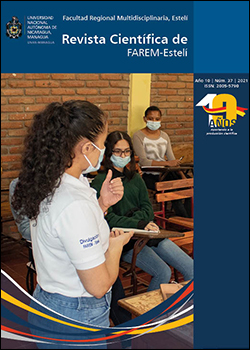Estimation of Biodegradability of CIRA/UNAN-Managua Wastewater Effluent according to ISO 10707 and OECD 301D
DOI:
https://doi.org/10.5377/farem.v0i37.11210Keywords:
Biodegradability, inoculum, reactor, biological, treatment, characterizationAbstract
The study to estimate the biodegradability of wastewater from CIRA/UNAN-Managua was carried out by implementing the ISO 10707 method and OECD 301D Guide Line, essays are known as last easy biodegradability or closed bottle test; for this, it was necessary to develop a liquid inoculum, from an aliquot from the effluent of the secondary settlers of a treatment system of biological origin in an aerated reactor of complete mixture; these microorganisms allowed biodegrading the organic matter of the wastewater. The research included an in situ inspection for the recognition of the ideal point where the samples were taken, as well as the measurement of the flow rate; in turn, the physical-chemical characterization of the effluent was carried out, comparing the results with what is established in the Regulation: Dispositions for the Discharge of Wastewater No. 21-2017 that specifies its Article 22. The estimate of the percentage of biodegradability was 94.78%, obtaining from this result that the effluent is readily biodegradable; parallel to this the analysis of the parameters according to the maximum permissible ranges to characterize provided acceptable values of the wastewater concerning the Regulation.
Downloads
References
Custodio Ruiz, A. (2008). Métodos y Técnicas de Invesigación Cienífica. México.
D. Eaton, A., S. Clesceri, L., W. Rice, E., & E. Greenberg, A. (2005). Standard Methods for the Examination of Water & Wasterwater. Washington, DC: American Public Health Association.
Gaceta, L. (30 de Noviembre de 2017). Decreto No. 21-2017. Reglamento en el que se establecen las disposiciones para el vertido de aguas residuales. Managua, Nicaragua.
ISO. (1999). ISO 9888:1999. En Water quality — Evaluation of ultimate aerobic biodegradability of organic - Static test (Zahn-Wellens method). Genève, Switzerland: Switzerland.
Kaiser. (1998). Review of biodegradability. Water Qual. Res. J. Canada, 85-211.
Laboratorio de Aguas Residuales. (2009). Procedimiento Operativo Normalizado. Managua: CIRA/UNAN-Managua.
Metálicos, L. d. (2019). Manual de Procedimientos Operativos Normalizados. Managua: CIRA/UNAN-Managua. Nicaragua.
OECD. (17 de Julio de 1992). OECD 301. Linea guía para pruebas de productos químicos. OECD.
Ottenbrite, & Albertsson. (1992). Discussion on degradation terminology: Biodegradable Polymers and Plastics. The Royal Society of Chemistry Cambridge, RU, 73-92.
Peña, D. (2013). Determinación de la relación DQO/DBO5 en aguas residuales.
Pocovi. (2003). Investigación cualitativa: Una alternativa viable. ITESO. México.
Residuales., L. d. (2019). Procedimiento Operativo del Aseguramiento y Control de la Calidad para la Medición del Caudal de Aguas Residuales y Naturales. Managua: CIRA/UNAN-Managua. Nicaragua.
Rodrigo, Y. (2015). Desarrollo y manejo de inóculos. Trujillo. Facultad de Ciencias Biologicas.
Tamayo Tamayo, M. (2002). El Proceso de la Investigación Científica. México: LIMUSA, S.A.
Vazquez Rodriguez, G., & Beltrán Hernández, R. I. (Enero de 2004). Pruebas Normalizadas para la Evaluación de la Biodegradabilidad de Sustancias Químicas. Estado de Hidalgo, México.
W. Rice, E., B. Baird, R., D. Eaton, A., & S. Clesceri, L. (2012). Standard Methods for the Examination of Water and Wastewaster, 22ND Edition. Baltimore: American Public Health Associatons.
Published
How to Cite
Issue
Section
License
Copyright (c) 2021 Revista Científica de FAREM-Esteli

This work is licensed under a Creative Commons Attribution-NonCommercial-ShareAlike 4.0 International License.

